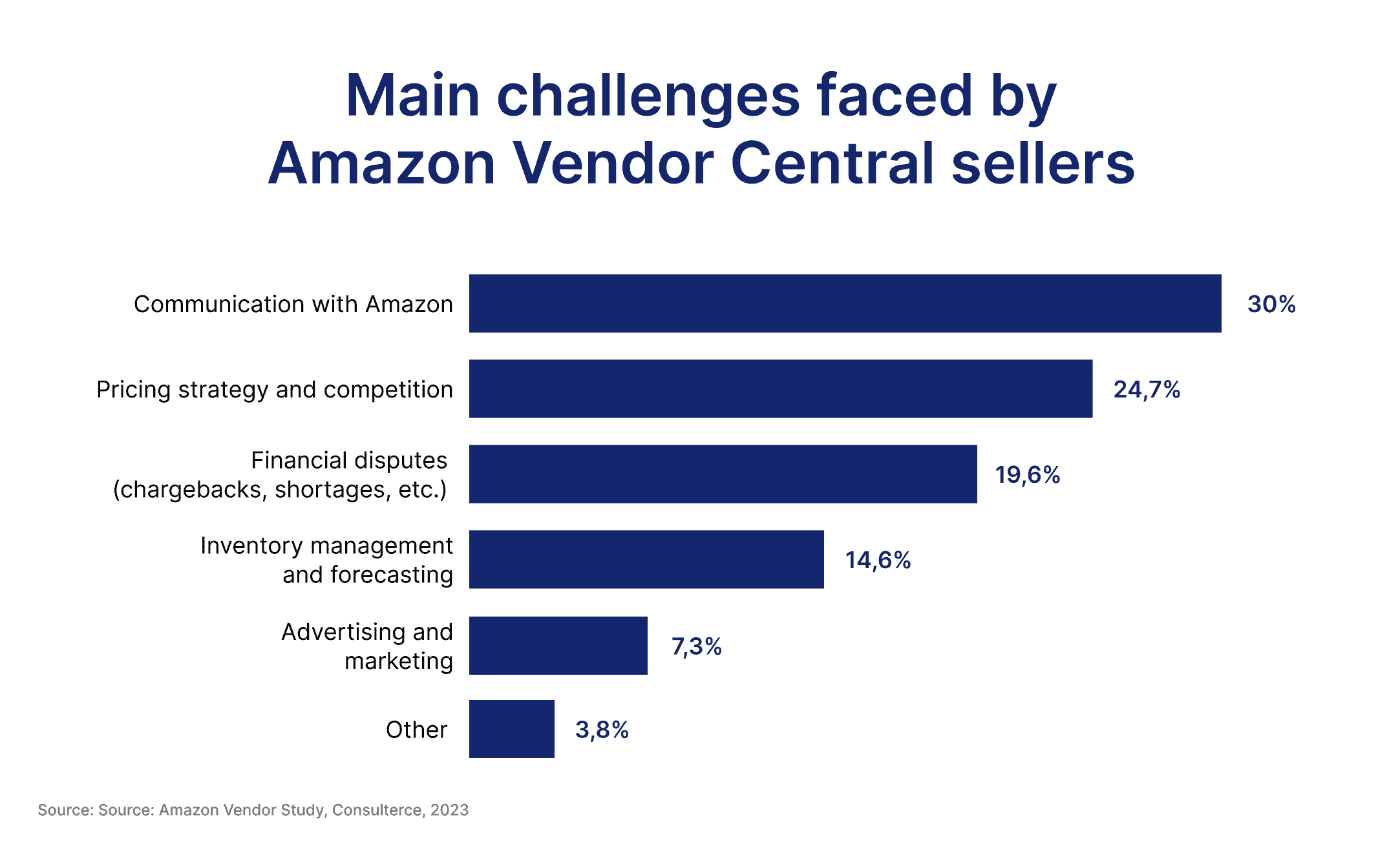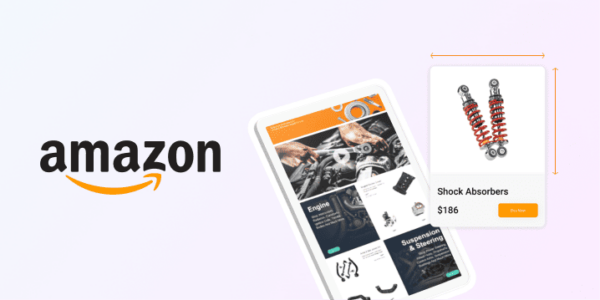
Amazon Seller Central vs. Vendor Central for global brands
If you’re looking into expanding your brand globally through Amazon, you’ve likely come across comparisons between Seller Central and Vendor Central.
In this article, we will dive into the pros and cons of Seller Central and Vendor Central. But that’s not all.
We’ll show you that there are other Amazon selling strategies that can enable your brand to expand globally. Read more to discover how an ecommerce accelerator can help brands conquer the world of online sales.
Pros and cons of Amazon Seller Central
Amazon Seller Central serves as a platform for third-party sellers (3P) to manage their listings, handle orders, and monitor their sales performance. It offers a significant amount of control for sellers, allowing them to:
- manage inventories,
- set prices,
- interact with customers directly.
This level of control can be a significant advantage for some.
The ability to manage own inventory gives sellers complete control over what products they sell, how many they stock, and when they restock. It allows for a quick response to changes in demand.
Sellers can also determine the best pricing strategy for their products, considering factors such as competition, demand, and profit margins.
Additionally, Seller Central allows to interact directly with customers. It can provide valuable insights into customer preferences and feedback.
However, such flexibility can also be a burden to some sellers.
It’s a lot of work to create and optimize listings, manage the virtual storefront, balance inventory levels to avoid stockouts or excess inventory, process orders, and on top of that – stay in touch with customers. In fact, for sellers who already struggle with this model, neglecting customer service is often the last nail in the coffin of their business, causing an avalanche of bad reviews that will ultimately impact sales negatively.

It’s good to keep in mind that even in the Seller Central model, brands with high volume can opt out of the FBM (Fulfilment by Merchant) model and outsource order fulfillment to Amazon through FBA (Fulfillment by Amazon) at an additional cost. FBA products will also get marked as Prime Eligible (available to Amazon Prime members for free shipping).
Another con of Seller Central is the sheer amount of third-party seller competition. Regarding visibility and sales, standing out and converting customers is challenging, especially in highly saturated markets.
The lack of access to certain Amazon programs and features available on Vendor Central can also be a disadvantage.
Pros and cons of Amazon Vendor Central
In contrast to Seller Central, Vendor Central is designed for those who want to obtain vendor status and sell products in bulk to Amazon as a wholesale supplier. Such first-party (1P) sellers are primarily manufacturers and distributors.
Through Vendor Central, vendors can manage their product catalog, handle inventory, and negotiate pricing and terms with Amazon. However, they do not sell directly to consumers – Amazon does that after purchasing the stock.
Such listings are marked as “sold by Amazon”, which instantly boosts customer confidence and opens the door to a significant customer base. It also qualifies the products to be eligible for Amazon Prime.
One of the major pros of Vendor Central is the potential for increased visibility. Products from Vendor Central partners have placement priority across Amazon’s platform, increasing chances of attracting customers and driving sales.
Historically, Amazon vendors had access to exclusive marketing and advertising programs (e.g., AMS, Subscribe & Save, Amazon Vine), which can further boost visibility and reach. However, some features, like A+ content, have also been rolled out to brand-registered third-party sellers.
[Get a FREE copy of the definitive guide to Advertising on Amazon]
There are also some cons to consider when it comes to Vendor Central.
One of the main drawbacks is the loss of control over pricing and inventory. In the Vendor Central model, Amazon reserves the right to make final changes to the product pricing. Vendors must adhere to Amazon’s pricing policies even if they don’t align with their global pricing strategy. In some cases, it could even interfere with the brand’s pricing on different platforms.
According to a 2023 study by Consulterce, the lack of effective communication with Amazon is the most common challenge among Vendor sellers, and over 64,5% of them described negotiating with Amazon as challenging, time-consuming, and inefficient.
The same research showed that annual negotiations (AVN) are a lengthy process that lasts between 1 and 6 months in most cases.
Another con is that the Vendor Central model will not follow any brand guidelines to protect the brand image.
If community is a core part of the brand’s identity, such a complete disconnect from the customer can be a drawback too. Lack of direct interaction can hinder the brand’s ability to uphold and convey its values effectively.
Finally, brands can join Vendor Central only upon invitation. Alternatively, they can try to request an invitation without any guarantee of being considered for becoming a Vendor Central partner.
Seller Central vs. Vendor Central: sum-up comparison
Now that we have explored the pros and cons of both Seller Central and Vendor Central let’s take a closer look at the key differences between these two Amazon selling models.
Amazon Seller Central is designed for third-party sellers who want to list and sell products directly to consumers on Amazon’s marketplace. It’s easy to set up, has a self-service style, and can be a perfect test platform for exploring new markets. It offers significant control for sellers, who must set prices, manage and process their inventories and orders, and interact directly with customers.
Seller Central equals more work but more control.
Amazon Vendor Central has a different approach, with the brand selling to Amazon as a first-party seller and Amazon acting as a direct buyer and reseller of products. It requires a certain stock volume and an efficient supply chain to meet potential demand. Amazon manages the inventory, pricing, and customer service. It offers increased visibility and customer confidence but less control over pricing and inventory.
Vendor Central equals less work but also less control.
We recommend considering all the options to make a fully informed decision about the right Amazon strategy for your brand.
There are selling models beyond Seller and Vendor Central worth considering for brands that want to go global.
Alternatives to Seller and Vendor Central: marketplace accelerator
What if you want more flexibility and branding opportunities… but less work?
Thankfully, in the rapidly evolving ecommerce landscape, brands can now access alternatives to Amazon’s traditional selling models. An ecommerce accelerator or a marketplace accelerator is one of them.
While both Seller Central and Vendor Central offer unique advantages, they also come with their own set of challenges and limitations.
Simply put – they lack the flexibility that brands often need. No wonder they are seeking alternative solutions such as ecommerce accelerators to provide greater adaptability, control, and profitability.
Take Webinterpret’s Marketplace Brand Expansion as an example: it’s a fully managed, AI-powered solution designed to enhance brands’ global presence on Amazon.
How does it work? Instead of shipping your inventory to Amazon, as you would in the Vendor Central model, you send it to Webinterpret’s local fulfillment centers, and the accelerator takes it from there, fast.
The key difference? This type of solution is partnership-oriented and allows you to remain in control regarding pricing and brand image.
Such a strategy is essentially a win-win model.
Once an ecommerce accelerator invests in the brand’s inventory, they are driven by a shared goal. The brand and the brand’s ecommerce accelerator will only profit if the products sell. Such an approach automatically guarantees the best ROI, and building brand recognition is a big part of that strategy.

Choose the right Amazon expansion strategy: checklist
When deciding on the best Amazon expansion model and strategy, several factors must be considered.
Here are some key questions you need to ask yourself to make an informed decision:
- How much experience do you have with Amazon?
- Can you stay up to date with all relevant Amazon algorithm changes and updates?
- How much control do you want over your brand image and customer experience?
- How important is visibility vs. brand recognition to you?
- Is your pricing strategy flexible or non-negotiable?
- How do you plan to fulfill your orders?
Final notes
Whether you’re a brand looking to scale up or an established enterprise seeking to diversify your sales strategy, Amazon can unlock new growth opportunities.
When it comes to expanding your brand globally on Amazon, understanding the nuances between different selling models and methods is crucial.
To choose the right selling strategy, it’s essential to analyze your brand’s specific needs and objectives. Ultimately, the model you choose needs to align with your brand’s goals, values, and resources.
While Amazon’s Seller Central and Vendor Central offer distinct advantages and challenges, alternatives such as marketplace accelerators are worth exploring. This innovative solution enables brands to effortlessly enhance their global presence – without sacrificing control.

Need a comprehensive Brand Expansion Checklist?
Sources
Related Posts:
Ecommerce Newsletter
By clicking the “Subscribe now” button, you agree to receive our monthly e-mail newsletter and regular marketing and commercial communications by email from Webinterpret regarding marketing trends and our digital marketing services. You confirm that you have read and agreed to Webinterpret’s Terms of Service and Privacy Policy.





